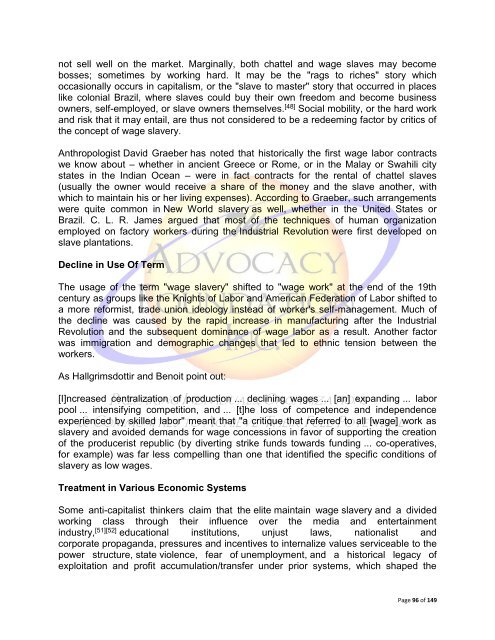Hidden Unemployment
Hidden Unemployment
Hidden Unemployment
Create successful ePaper yourself
Turn your PDF publications into a flip-book with our unique Google optimized e-Paper software.
not sell well on the market. Marginally, both chattel and wage slaves may become<br />
bosses; sometimes by working hard. It may be the "rags to riches" story which<br />
occasionally occurs in capitalism, or the "slave to master" story that occurred in places<br />
like colonial Brazil, where slaves could buy their own freedom and become business<br />
owners, self-employed, or slave owners themselves. [48] Social mobility, or the hard work<br />
and risk that it may entail, are thus not considered to be a redeeming factor by critics of<br />
the concept of wage slavery.<br />
Anthropologist David Graeber has noted that historically the first wage labor contracts<br />
we know about – whether in ancient Greece or Rome, or in the Malay or Swahili city<br />
states in the Indian Ocean – were in fact contracts for the rental of chattel slaves<br />
(usually the owner would receive a share of the money and the slave another, with<br />
which to maintain his or her living expenses). According to Graeber, such arrangements<br />
were quite common in New World slavery as well, whether in the United States or<br />
Brazil. C. L. R. James argued that most of the techniques of human organization<br />
employed on factory workers during the Industrial Revolution were first developed on<br />
slave plantations.<br />
Decline in Use Of Term<br />
The usage of the term "wage slavery" shifted to "wage work" at the end of the 19th<br />
century as groups like the Knights of Labor and American Federation of Labor shifted to<br />
a more reformist, trade union ideology instead of worker's self-management. Much of<br />
the decline was caused by the rapid increase in manufacturing after the Industrial<br />
Revolution and the subsequent dominance of wage labor as a result. Another factor<br />
was immigration and demographic changes that led to ethnic tension between the<br />
workers.<br />
As Hallgrimsdottir and Benoit point out:<br />
[I]ncreased centralization of production ... declining wages ... [an] expanding ... labor<br />
pool ... intensifying competition, and ... [t]he loss of competence and independence<br />
experienced by skilled labor" meant that "a critique that referred to all [wage] work as<br />
slavery and avoided demands for wage concessions in favor of supporting the creation<br />
of the producerist republic (by diverting strike funds towards funding ... co-operatives,<br />
for example) was far less compelling than one that identified the specific conditions of<br />
slavery as low wages.<br />
Treatment in Various Economic Systems<br />
Some anti-capitalist thinkers claim that the elite maintain wage slavery and a divided<br />
working class through their influence over the media and entertainment<br />
industry, [51][52] educational institutions, unjust laws, nationalist and<br />
corporate propaganda, pressures and incentives to internalize values serviceable to the<br />
power structure, state violence, fear of unemployment, and a historical legacy of<br />
exploitation and profit accumulation/transfer under prior systems, which shaped the<br />
Page 96 of 149

















